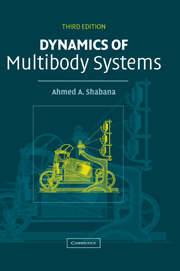1 - INTRODUCTION
Published online by Cambridge University Press: 10 November 2009
Summary
MULTIBODY SYSTEMS
The primary purpose of this book is to develop methods for the dynamic analysis of multibody systems that consist of interconnected rigid and deformable components. In that sense, the objective may be considered as a generalization of methods of structural and rigid body analysis. Many mechanical and structural systems such as vehicles, space structures, robotics, mechanisms, and aircraft consist of interconnected components that undergo large translational and rotational displacements. Figure 1 shows examples of such systems that can be modeled as multibody systems. In general, a multibody system is defined to be a collection of subsystems called bodies, components, or substructures. The motion of the subsystems is kinematically constrained because of different types of joints, and each subsystem or component may undergo large translations and rotational displacements.
Basic to any presentation of multibody mechanics is the understanding of the motion of subsystems (bodies or components). The motion of material bodies formed the subject of some of the earliest researches pursued in three different fields, namely, rigid body mechanics, structural mechanics, and continuum mechanics. The term rigid body implies that the deformation of the body under consideration is assumed small such that the body deformation has no effect on the gross body motion. Hence, for a rigid body, the distance between any two of its particles remains constant at all times and all configurations. The motion of a rigid body in space can be completely described by using six generalized coordinates. However, the resulting mathematical model in general is highly nonlinear because of the large body rotation.
- Type
- Chapter
- Information
- Dynamics of Multibody Systems , pp. 1 - 27Publisher: Cambridge University PressPrint publication year: 2005

